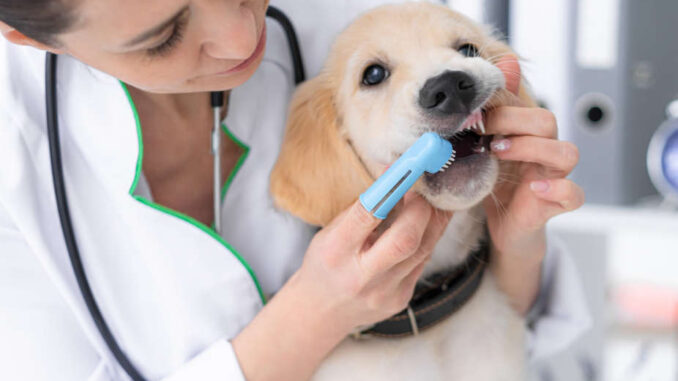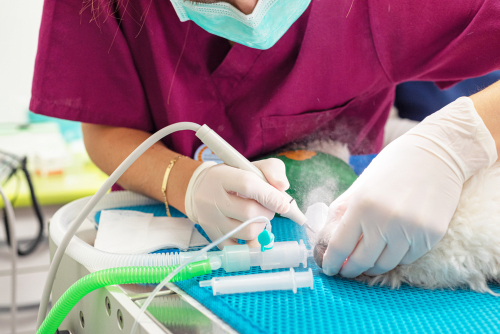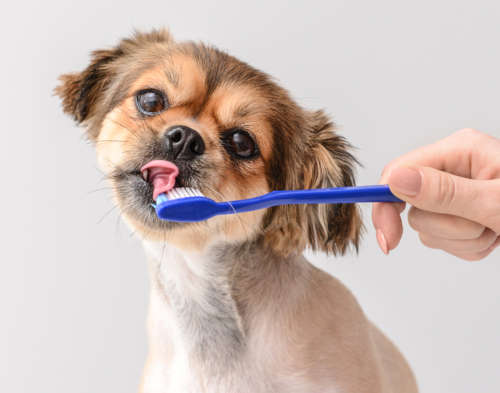
This article was updated on November 14th, 2023
Tartar buildup is a prevalent problem in dogs: as a veterinarian, I see this issue every day! If left untreated, tartar can also lead to severe dental diseases.
However, tartar is preventable and can be removed. In this article, I will share the 5 best ways to eliminate tartar buildup and avoid dental problems for your furry companion.
5 Best Ways to Remove Tartar on Dog’s Teeth [Vet Approved]
Dental health is something that both your vet and you will need to work on. Here are some ways that you can professionally rid your dog’s teeth of tartar and ways it can be done at home.
1. Professional Cleaning
How effective it is: 5.0/5.0 stars, cost: $100-$500+


How to do it well: Have your pet’s teeth professionally cleaned every six months or more for dogs with crowding or other dental issues.
Why this helps: The best dog tartar removal is a professional cleaning by your veterinarian. Most dental cleanings are done under sedation or anesthesia so that your vet gets a good look at all of your dog’s teeth and can completely remove tartar from all surfaces. They can treat abscess and loose or broken teeth during a dental as well.
When is it recommended: Veterinary dentals are recommended every six months for most healthy adult dogs. However, a professional cleaning should be done any time there is inflammation or pain in the mouth or when tartar covers 25% or more of the tooth surface.
2. Tooth Brushing
How effective it is: 4.5/5.0 stars, cost: $10-$20


How to do it well: Dogs should have their teeth brushed ideally once a day, however 2-3 times per week is also very beneficial.
Why this helps: The combination of brushing and enzymatic toothpaste helps to soften and remove tartar and remove plaque to prevent tartar from forming. Brushing the gums can also help stimulate healing to reduce inflammation. CET makes a great pet toothbrush and toothpaste, as listed below:
No products found.
- FOR DOGS AND CATS: Enzymatic toothpaste specifically formulated using an enzyme system for dogs and cats to reduce plaque, freshen breath, and ensure a clean mouth. Poultry flavor pets love
When is it recommended: Tooth brushing is recommended for any dog at any time. Of course, it works best to prevent tartar buildup, so starting with a professionally cleaned mouth will have the best results. But that doesn’t mean that brushing teeth that already have some buildup won’t aid in removing tartar from dog teeth.
3. Dental Gels and Sprays
How effective it is: 3.8/5.0 stars, cost: $10-$20

How to do it well: Dental gels and sprays are applied to teeth to enzymatically help break up tartar buildup. It’s best to apply at least once a day and allow 30 minutes without eating or drinking.
Why it helps: Dental gels and sprays are a no-brush way of softening and breaking up stuck on tartar. Using these products does require a small time commitment and usually works better at preventing buildup. Some good products to try are Orotene Brushless Toothpaste Gel and Pets are Kids Too Premium Pet Dental Spray, as listed below:
- Clear gel with a pleasant flavor that helps to keep your pet's teeth & gums clean & smelling fresh
- Advanced Pet Breath Freshener - Our premium dog mouth spray tackles bad breath at its source! This powerful dog dental spray and cat breath freshener delivers long-lasting freshness while supporting complete oral health for your pets.
When is it recommended the most: Most dental gels and sprays work better following a professional cleaning since they are best at preventing tartar buildup. However, they can remove mild to moderate tartar and work especially well for dogs that won’t tolerate tooth brushing.
4. Dental Chews
How effective it is: 3.5/5.0 stars, cost: $8-$25

How to do it well: Dental chews need to be used regularly in order to remove tartar buildup. Like other similar products, they work best when starting with a clean mouth and preventing tartar formation. Be sure to get the proper size for your dog to ensure the best use and to prevent choking.
Why it helps: Dental chews are large and textured to help mechanically scrape tartar from your dog’s teeth while they chew them. Greenies are the posterchild for dog dental chews and tend to work well.
- The unique texture of Greenies Dog Chews cleans down to the gumline to fight plaque and tartar and freshen breath
When is it recommended: Dental chews work well at preventing tartar but can also remove mild to moderate amounts of tartar buildup.
5. Dental Wipes
How effective it is: 3.5/5.0 stars, cost: $10-$20

How to do it well: Dental wipes need to be used at least once a day for best results.
Why it helps: Most dental wipes for dogs work by enzymatically removing plaque and tartar. They work similar to a dental gel but also are somewhat of a mechanical dog tartar removal tool. Wipes are generally better tolerated than brushing. Vet’s Best Dental Care Finger Wipes work pretty well at removing tartar from a dog’s teeth. See listing below:
- CLEANS TEETH & GUMS: Keep your pet's teeth and gums clean and healthy with these cat and dog dental wipes; perfect for keeping your pet's mouth clean and fresh, these wipes promote good oral hygiene and help prevent tartar and plaque buildup
When it is recommended: Dental wipes are a good option for a mix of mechanical and enzymatic tartar removal in dogs that won’t tolerate brushing. They may be effective at removing mild to moderate tartar.
How Much Tartar Does Your Dog Have? (and What to Do)
If you haven’t already, it’s time to lift your dog’s lips and get a view of their teeth to see how much tartar they have brewing in there.
Clean Teeth

With any luck, your pup’s pearly whites will be just that. A nice clean mouth without tartar buildup, red gums or painful eating is where you want to be. No professional action is needed at this time, but keep a close eye as tartar only takes a few days to form. You will want to start some preventative measures like tooth brushing, dental gels, sprays, or wipes at this point to keep those teeth sparkling.
Mild Tartar

If your pup’s teeth are showing a ring of brown at the gums with a little inflammation, you’re not doing too bad. But now’s the time to get in there and get something done. Tooth brushing, dental gels, sprays and wipes should break up this tartar. Dental chews may also help.
Moderate Tartar

If your pup has teeth like these but isn’t painful, you may start with some dental chews, brushing, gels, or wipes. Give these products a couple weeks of regular use and see if you’re making any progress. If not, it’s time to visit your vet.
Severe Tartar

You’re best off to start with a professional here. Chances are your pup is experiencing some pain and other dental products will just take too long to work. Get them in for a dental checkup and cleaning to hopefully prevent any tooth loss.
Wrapping it Up: Tartar Can Make a Dog’s Life Miserable. When Is It Time to Act?
Tartar is more than just an ugly accumulation on your dog’s teeth. It can actually be the root of some serious whole-body issues. It all starts with plaque, a sticky mix of bacteria that forms a film on teeth. It is easily removed with brushing or other products. If plaque isn’t removed, it can harden into tartar that is more difficult to remove and can create inflammation of the gums and other tissues of the mouth. Tartar can cause:
- Bad breath: This is one that’s going to affect you most. No one wants a dog kiss from a stinky mouth.
- Loose teeth: Tartar accumulation can infect and weaken the tissues holding the teeth in place causing teeth to fall out or need to be removed by your vet.
- Mouth pain: Loose teeth and inflamed gums make it painful for your pup to chew. Serious issues can even lead to a reduced appetite and weight loss.
- Infection: When tartar gets out of hand, bacteria can cause abscesses in the roots of teeth or even in the bone of the jaw, both requiring extensive treatment.
- Systemic infection: Bacteria in the mouth don’t always stay in the mouth. They can enter the bloodstream and cause problems in other areas of the body, mainly the heart, liver and kidneys.
How Common is Tartar a Problem in Dogs?
When I said that tartar is something vets see every single day, it’s not an exaggeration. In fact, dental disease due to tartar affects over 80% of dogs over three years of age. That’s a lot! This means that at least eight out of every 10 adult dogs that come into a veterinary clinic on any given day have some stage of tartar buildup, gum and gingival inflammation, bad breath, and potentially loose teeth.
While stinky breath is one minor thing to deal with, losing teeth and painful eating is entirely another, not to mention the potential for infections spreading to the all important heart, liver, and kidneys. Tartar buildup on a dog’s teeth is a big deal, and it’s something that you can deal with at home.
Disclaimer: This website's content is not a substitute for veterinary care. Always consult with your veterinarian for healthcare decisions. Read More.







Be the first to comment